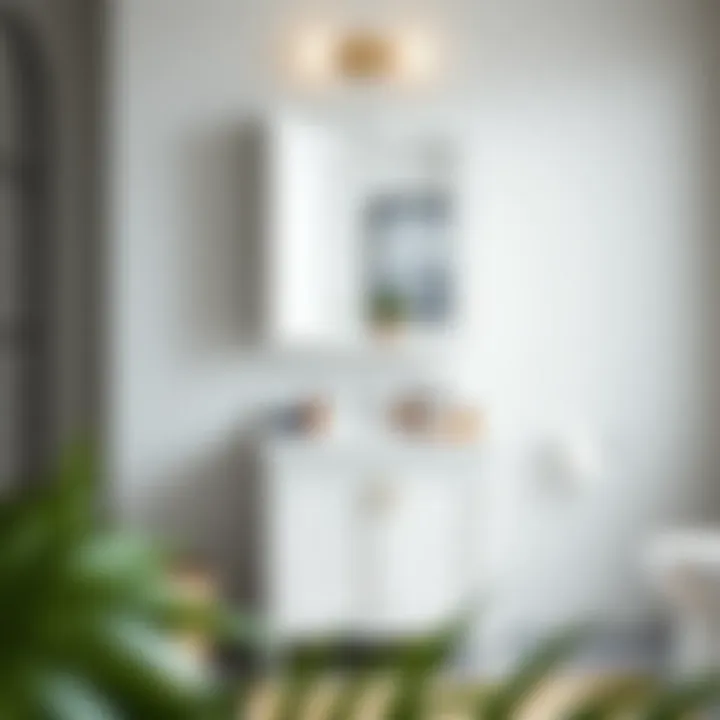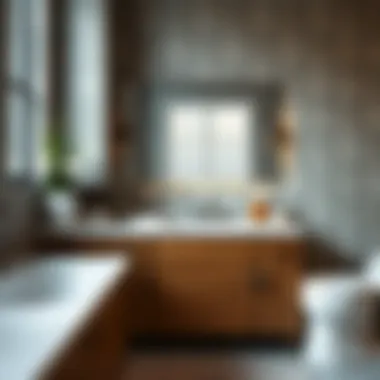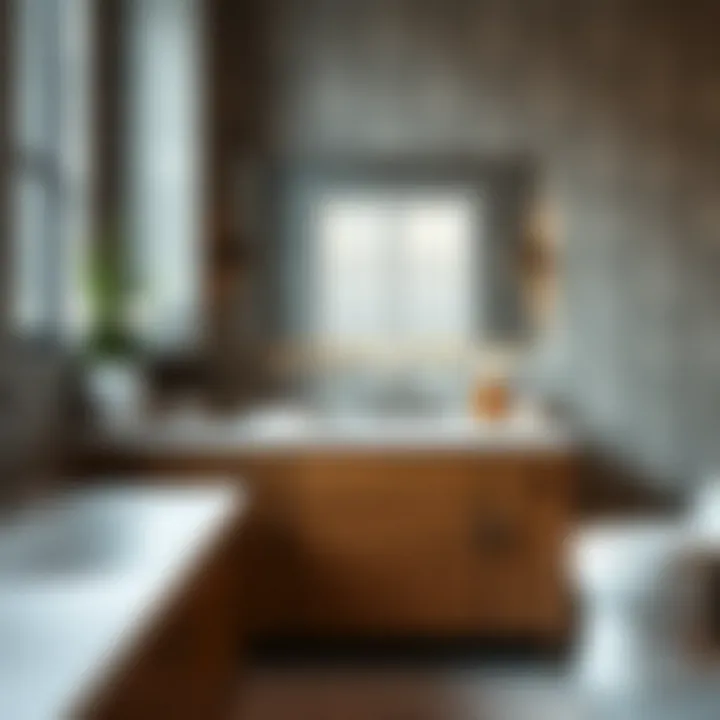Counter Height Bathroom Cabinets: A Complete Guide


Intro
In recent years, the design landscape has seen a subtle shift towards the increasing popularity of counter height bathroom cabinets. This trend reflects a growing recognition of their multifaceted functionality and aesthetic appeal. No longer just a place for towels and toiletries, these cabinets serve as essential elements that enhance both the practical aspects and visual qualities of bathrooms. The right counter height cabinet can transform an ordinary bathroom into a delightful retreat, making it a space where style and utility harmoniously coexist.
As we navigate through this comprehensive guide, we'll explore the dimensions, practical applications, and design possibilities that counter height bathroom cabinets present. We will also dissect the various materials available, discuss maintenance tips, and help you integrate these space-saving solutions into your existing design scheme.
With the focus on elegance and practicality, this guide aims to arm homeowners, designers, and decorators alike with the insights needed to make informed selections that not only meet their needs but also elevate their unique spaces. Whether you're rebuilding a bathroom or simply refreshing the décor, this exploration will ensure you have all the tools to make counter height cabinets work for you.
Design Inspiration
Incorporating counter height bathroom cabinets into your design scheme calls for inspiration that aligns with today's trends. Let's delve into some fresh ideas and color combinations that can spark your creativity.
Trending Furniture Styles
Counter height bathroom cabinets come in a variety of styles that cater to diverse tastes. From contemporary to rustic, there's no shortage of options to reflect your personality.
- Modern Minimalism: Sleek lines and simple hardware can make a stunning statement in a compact bathroom.
- Rustic Charm: Reclaimed wood finishes bring warmth and character, perfect for creating a cozy, vintage vibe.
- Classic Elegance: Intricate woodwork and a traditional color palette can add a touch of sophistication.
- Industrial Edge: Metal accents paired with distressed woods can set a bold tone that marries strength with style.
These categories showcase just a glimpse of what's achievable, but consider experimenting with hybrid styles that suit your specific taste.
Color Palettes and Combinations
A successful color scheme can elevate the look and feel of your space. One way to play around with colors is to create combinations that breathe life into your bathroom while adhering to the overall theme.
- Cool Blues and Greens: These colors give a serene effect, reflecting water's natural hues, ideal for a relaxing atmosphere.
- Bold Accessories: Choosing bright colors for accessories can infuse energy into neutral cabinets, making the space feel vibrant.
- Earthy Tones: Shades like terracotta and olive green can tie in with wood materials for a grounded, organic feel.
Keeping these contrasting colors or harmonized palettes in mind allows for a balance that can make the cabinet stand out while complementing other elements in the bathroom.
"The right blend of color and style can significantly alter not just the aesthetic, but the whole atmosphere of your bathroom."
In the following sections, we will dive deeper into practical advice that includes maintenance tips to prolong the life of your cabinets, as well as ways to effectively plan your space around these essential fixtures.
Prelude to Counter Height Bathroom Cabinets
When you step into a bathroom, what usually catches your eye? It might be the sleek tiles, the luxurious fixtures, or perhaps the innovative storage solutions. In recent years, counter height bathroom cabinets have emerged as a game-changer in bathroom design, blending functionality with aesthetics in a way that's hard to overlook. Understanding these cabinets is not just for interior designers; it's for homeowners looking to elevate their space without sacrificing practicality.
Definition and Dimensions
To get a clear picture, let's define counter height bathroom cabinets. Typically, these cabinets stand between 34 to 36 inches off the ground, similar to standard kitchen counters. This height makes them easily accessible, especially for adults, while also allowing for convenient storage solutions. These cabinets often come in various widths and depths, tailored to fit different bathroom layouts. What’s essential here is that they strike a balance between style and usability; you can store towels, toiletries, and other necessities conveniently, all while keeping your bathroom clutter-free.
Consider the design of your space when choosing dimensions. A small bathroom may benefit from narrower cabinets, while a more spacious master bathroom can showcase wider, more elaborate designs. Remember, the beauty of counter height cabinets lies in their adaptable nature—there's something for every bathroom.
Popularity and Trends
The surge in popularity for counter height bathroom cabinets isn’t accidental. The rise of open concept homes and minimalist trends has paved the way for these cabinets to shine. Homeowners are increasingly seeking to create cohesive design elements throughout their living spaces. By choosing cabinets that align with the aesthetics of the rest of the house, you not only maximize storage but also enhance the visual appeal of your bathroom.
In today's design landscape, counter height cabinets symbolize a blend of style and practicality, appealing to those who value both.
From contemporary looks with sleek finishes to rustic designs featuring distressed wood, there's a trend that suits just about everyone. Plus, with the push for sustainability, many manufacturers are now offering eco-friendly materials, allowing you to have both a chic and environmentally conscious space.
In summary, understanding counter height bathroom cabinets involves recognizing their definition, dimensions, and ever-growing popularity. Homeowners, designers, and decorators alike must consider how these cabinets can transform a bathroom from mundane to magnificent. A deeper exploration into their design advantages and material considerations can further enhance your understanding of their place in modern bathrooms.
Design Advantages of Counter Height Cabinets
When it comes to bathroom cabinetry, counter height cabinets stand out for several compelling reasons. Their design advantages can influence not just the look of your bathroom but also how it functions as a space. Let’s delve deeper into three key benefits: enhanced accessibility, aesthetic appeal, and spatial optimization.
Enhanced Accessibility
One of the primary advantages of counter height cabinets is the accessibility they offer. These cabinets typically sit at a height of about 34 to 36 inches, making them ideal for a wider range of users. Imagine elderly family members or anyone with mobility challenges trying to reach items stored in a standard height cabinet. Counter height cabinets can prove a game changer, allowing for easier access without the need to stretch or bend awkwardly.


This design choice also supports ergonomic principles. Everyday tasks, like applying makeup or grooming, become significantly simpler and more comfortable. Forget the hassle of stooping low to rummage through cluttered under-sink cabinets. Instead, a counter height cabinet keeps essentials right at your fingertips, enhancing overall functionality.
"Practicality is often overlooked in aesthetics, but counter height cabinets merge both wonderfully, transforming usability in the bathroom."
Aesthetic Appeal
Not to be underestimated is the aesthetic advantage that comes with counter height cabinets. They bring a modern, chic vibe to any bathroom environment, transcending traditional cabinetry styles. The clean lines and elevated presence can create an illusion of space, making smaller bathrooms feel more open and inviting.
Additionally, there’s a vast array of design options when it comes to styles, colors, and finishes. Homeowners can opt for sleek contemporary designs featuring minimalist handles or choose classic looks with ornate details. A well-designed counter height cabinet not just serves a functional purpose but also acts as a statement piece that enhances the overall decor. Whether you prefer a natural wood finish for a rustic feel or a glossy white for a more contemporary look, these cabinets can be tailored to fit your unique aesthetic.
Spatial Optimization
In many homes, space can be a premium. Counter height cabinets offer innovative ways to make the most of available areas. Unlike traditional cabinetry that may occupy significant wall space, these cabinets can be designed to extend vertically, drawing the eye up and creating a perception of height.
Some homeowners might even consider floating counter height cabinets. These can provide storage without taking up floor space, which is particularly advantageous in compact bathrooms. Coupled with strategically placed mirrors, the combination can create an optical illusion of a larger, brighter room.
Furthermore, considering added features like shelves or cubbies can help in organizing and decluttering essentials, encouraging more efficient use of space.
Material Considerations
When embarking on a venture to select bathroom cabinets, one of the most paramount aspects to ponder is the material that will construct them. This section focuses on Material Considerations, elucidating the essence of choosing the right materials in your quest for counter height bathroom cabinets. Each material comes with its unique traits, advantages, and disadvantages, which can significantly impact not just aesthetics but also the practical aspects of durability and maintenance.
Wood Options: Durability and Style
Wood has long maintained its position as a reputable choice in cabinetry. It offers a blend of natural beauty and resilience. Various wood species, such as oak, maple, and cherry, each possess distinct characteristics. Oak is celebrated for its strength and grain pattern while maple is often chosen for its sleek look and fine texture. Though wood may be prone to warping in high-moisture environments, treatments and finishes can enhance its durability.
Another consideration is the environmental impact. Sustainable wood options are gaining traction among environmentally-conscious homeowners. It’s important to check for certifications like the Forest Stewardship Council, which guarantees responsible sourcing of wood. This way, you can indulge in style without the hefty conscience that sometimes tags along with global sourcing issues.
Metal and Composite Materials
In recent years, metal and composite materials have begun to hold their ground, appealing to those leaning towards a modern aesthetic or tech-savvy functionality. Metal, particularly stainless steel, is not only sturdy but also provides a sleek, contemporary feel. It can withstand the harsh conditions often met in bathrooms, making it ideal for high humidity and frequent cleaning.
On the other hand, composite materials combine various substances to create a product that's both economical and visually appealing. Items such as medium-density fiberboard (MDF) come with reliable stability and resistance to warping—factors to consider for humid bathroom settings. The versatility in design and finishes offered by composites allows for a mélange of styles, from ultra-modern to rustic-chic. However, it's crucial to keep in mind that while these materials may be easier to maintain, they can sometimes lack the timeless appeal of solid wood.
Maintenance and Longevity
Regardless of the material chosen, understanding maintenance is essential for ensuring longevity and functionality. Wood requires regular upkeep, including polishing and protective treatments to retain its luster and uphold its resistance to moisture. The methodical application of wax or preserver can be vital. Conversely, cleaning composite materials or metals might only require occasional wipes with simply detergents. Yet, knowing how your chosen material performs against everyday wear and tear is critical.
"The choice of material in your bathroom cabinets not only shapes the overall ambiance, but it also dictates how you will interact with your space daily."
In summary, when weighing options for bathroom cabinets, don’t just think aesthetics. Instead, dive deep into the characteristics of each material, considering how they align with your lifestyle and maintenance preferences. The right choice will ultimately enhance both the functionality and visual appeal of your bathroom, making it a sanctuary of comfort and style.
For further insights into wood properties, you might explore Wikipedia or the Wood Database. For more on composite materials, visiting Britannica could provide additional clarity.
Selecting the Right Style
Selecting the appropriate style for counter height bathroom cabinets is imperative when it comes to achieving a cohesive and functional design. A well-chosen cabinet style can enhance both the beauty and practicality of the space. It is not just about aesthetics; the right style can complement the existing architecture and fixtures, creating an inviting atmosphere.
Modern vs. Traditional Designs
When it comes to style, modern and traditional designs cater to different tastes. Modern designs often feature sleek lines, minimal ornamentation, and a focus on materials like glass and metals. They tend to incorporate open shelving and a more open layout that emphasizes spaciousness. On the other hand, traditional designs showcase rich woods, intricate carvings, and more classic, ornate details. These designs evoke a sense of warmth and familiarity, often resonating with those who appreciate classic craftsmanship.
Choosing between these styles requires consideration of several factors:
- Personal Preference: Whether you lean towards sleek minimalism or rich classic details.
- Existing Decor: How well the cabinetry will blend with other design elements in your bathroom.
- Functional Needs: Some designs offer more storage solutions than others, which can be essential in smaller spaces.
Customization Options
Customization in cabinetry allows homeowners to create a unique look tailored to their specific needs. This can include everything from selecting the type of hardware that fits the design to altering dimensions for better fit and usage. Customization options can include:


- Size Adjustments: Tailoring height and width to accommodate unique spaces.
- Special Features: Such as built-in organizers, hidden compartments, or unique shelving patterns.
- Material Selection: Different options provide various looks and durability, from solid woods to composites.
Customization makes it possible to ensure that the cabinetry not only fits within the design aesthetic but also caters to individual functionality needs.
Color and Finish Choices
The color and finish of counter height cabinets play a huge role in defining the bathroom's overall vibe. Light colors tend to open up spaces and provide a clean look, while darker shades can offer a dramatic elegance.
- Popular Color Choices: White, grey, navy blue, and earth tones.
- Finish Options: Matte, gloss, or distressed finishes can significantly affect perception. Matte finishes tend to hide fingerprints and water spots, while gloss finishes can reflect light and create a larger appearance.
Selecting the right color and finish can elevate the aesthetics of your bathroom, creating a harmonious and inviting atmosphere.
In summary, understanding your style preferences, the decor in your home, and the needs of your space can guide you in selecting the right counter height bathroom cabinets. Taking the time to explore modern versus traditional designs, dive into customization options, and carefully choose colors and finishes will ultimately lead to a bathroom that is both functional and pleasing to the eye.
Practical Applications in Various Settings
Practical applications of counter height bathroom cabinets can significantly influence the overall function and style of a bathroom. The height of these cabinets makes them ideal for maximizing storage and ensuring ease of access, addressing common pain points in various settings. Emphasizing practicality alongside elegance, these cabinets can blend seamlessly into different bathroom types, such as small bathrooms, master bathrooms, and guest bathrooms. Each setting presents unique challenges and opportunities that counter height cabinets uniquely meet.
Small Bathrooms
In small bathrooms, every inch matters. Counter height cabinets offer a smart solution where space is at a premium. They provide essential storage without overwhelming the area. For instance, think about narrow cabinets that fit snugly beside a sink, or even over-the-toilet designs that take advantage of vertical space. Well-designed small bathrooms might utilize these cabinets to house toiletries and linens, keeping surfaces clear and organized.
A notable benefit of counter height cabinets in compact settings is their ability to create a sense of openness. Higher cabinets can draw the eye upwards, giving an illusion of height and making the room feel less cramped. Additionally, homeowners can select lighter colors or mirrors on cabinet fronts to enhance that airy feel.
Master Bathrooms
Master bathrooms serve as a personal retreat, and counter height cabinets play a pivotal role in this context. They cater to those who appreciate a blend of form and function. These cabinets can be integrated into double-sink vanity layouts, where the height aids in creating a more comfortable grooming experience. With ample storage capacity, they can house everything from beauty products to towels, leading to a streamlined and serene environment.
Moreover, master bathrooms often embrace luxury and style. Counter height cabinets can be crafted with rich woods or sleek finishes, transforming them into design statements that enhance the overall aesthetic. Homeowners might choose to install decorative hardware or incorporate built-in lighting to elevate the decor.
Guest Bathrooms
Guest bathrooms present a slightly different challenge but offer numerous opportunities for the use of counter height cabinets. They serve as a quick stop for visitors, so function cannot be compromised. Counter height cabinets allow for easy access to necessary items like extra toiletries and linens, all while maintaining a polished appearance.
When thinking about design, consider how counter height cabinets can transition seamlessly into the overall guest bathroom decor. Opt for materials that are easy to clean and maintain, as guest bathrooms will see varied use. Additionally, integrating aesthetic elements that reflect the style of the home, such as matching faucet finishes with cabinet hardware, can leave a warm impression on guests.
The versatility of counter height cabinets helps harmonize functionality and aesthetics across various bathroom styles, enhancing user experience in every setting.
A thoughtful approach to these practical applications encourages homeowners to view counter height cabinets not merely as storage solutions, but also as integral elements of bathroom design. Each setting presents its own needs, and tailored solutions with these cabinets can vastly improve both utility and visual appeal.
Installation Guidelines
When tackling the installation of counter height bathroom cabinets, it's crucial to fully understand the specific guidelines that govern the process. This section aims to gather insights on how to prepare the space, what to consider regarding ventilation and plumbing, and whether to hire professionals or dive into a DIY project. Getting the installation right not only boosts the functionality of your bathroom but also enhances its overall appeal.
Preparation of Space
Before installing any cabinetry, the initial space preparation plays a pivotal role. First and foremost, you should measure the area accurately. Ensure the wall, floor, and ceiling are level, as uneven surfaces can lead to improper alignment and functionality issues down the line.
- Remove Existing Fixtures: Clear any existing cabinetry, countertops, or fixtures in the area that could obstruct the new installations.
- Check for Electrical Wiring: Be aware of electrical outlets that may be within the planned cabinetry area.
- Clean the Area: A clean workspace not only makes the installation easier but also prevents future maintenance issues. Dust, grime, and residues can cause complications.
In short, preparing the area methodically sets a solid foundation for everything that follows.
Ventilation and Plumbing Considerations
As you embark on this installation journey, considerations around ventilation and plumbing cannot be overlooked. Proper ventilation is essential, especially in a bathroom setting where moisture is prevalent. Good airflow helps to prevent mold and mildew.
- Ventilation Needs: If your cabinet installation involves a sink or other water application, consider integrating a cabinet model that can accommodate additional air circulation.
- Plumbing Adjustments: Be mindful that plumbing lines will need to connect seamlessly with any new cabinets. You may need to reconfigure them based on the height and depth of the cabinetry you have selected.
- Pipes and Drainage: Know the placement of drainage pipes. Minor changes can lead to major headaches if not properly assessed.
Planning out these details first can save you a lot of time and energy later on.


Professional vs. DIY Installation
Deciding whether to hire professionals or to take the DIY route ultimately hinges on your skills, experience, and time availability. Here’s a closer look at the pros and cons of both situations:
Professional Installation
- Expertise: Professionals bring experience that ensures the job is done accurately.
- Efficiency: They often complete installations faster, allowing for quick use of your new cabinetry.
- Guaranteed Results: Most professionals offer some form of warranty, providing peace of mind.
DIY Installation
- Cost Savings: This route can be more budget-friendly since you save on labor costs.
- Complete Control: You can tailor everything to your personal style and preferences.
- Learning Experience: Taking on a project like this can deepen your understanding and skills.
If choosing to do it yourself, ensure you have a clear step-by-step plan and consult online resources or manuals for guidance.
Ultimately, whichever path you choose, being well-informed enables a smooth installation process, ensuring that your counter height bathroom cabinets transform your space into a practical yet aesthetically pleasing area.
Maintenance Tips for Longevity
Maintaining counter height bathroom cabinets is crucial for ensuring they last and stay looking sharp. These cabinets often serve as central pieces in a bathroom, combining functionality and aesthetics. By prioritizing maintenance, homeowners can extend the life of their cabinetry, keeping it functional and appealing for years down the line. Regular attention not only preserves the physical appearance but also prevents major repairs and replacements that can prove costly.
Cleaning Protocols
To keep your counter height cabinets in tip-top shape, a consistent cleaning regimen is essential. Use a soft cloth or microfiber towel to wipe down surfaces regularly. Avoid using abrasive cleaners that might scratch or damage the finish. A simple mixture of warm water and mild detergent can work wonders. Make sure to dry surfaces promptly to prevent water spots or stains, particularly if your cabinetry features natural wood or painted finishes.
Proper cleaning not only enhances appearance but also adds years to your cabinets.
Key tips for cleaning:
- Use soft materials like microfiber to avoid scratches.
- Avoid bleach and ammonia-based products.
- For stained areas, a mixture of vinegar and baking soda can provide gentle abrasion to lift marks, especially on wood surfaces.
Periodic Inspections
Every once in a while, it’s wise to inspect your cabinets for any issues. Check joints, hinges, and surfaces for signs of wear or damage. Watch out for any moisture buildup, especially around sinks, as water can warp or damage the cabinets over time. By catching these problems early, you save yourself from bigger headaches later. This proactive approach not only caters to the health of your cabinets but enhances their longevity.
What to look for during inspections:
- Cracks in the surface or joints.
- Loose hardware that may need tightening.
- Signs of mold or mildew, especially in humid bathroom environments.
Repairing Common Issues
Even with careful maintenance, issues can arise. Thankfully, many common problems are easy to rectify. If you notice scratches, a little wood filler can often fix the blemish. For cabinetry that’s become loose due to wear and tear, simply re-tightening screws or replacing hardware can rectify functionality issues. Keep a small toolkit handy for little repairs before they evolve into major headaches.
Easy repairs you can handle:
- Use wood filler and sandpaper for minor scratches.
- Tighten screws found in hinges and drawer slides to enhance function and alignment.
- Replace handles and knobs that may have seen better days, as this can refresh your cabinet’s look instantly.
Maintaining counter height bathroom cabinets doesn't just enhance their look but also ensures a healthy and functional bathroom space. With a bit of cleaning, periodic checks, and swift repairs, homeowners can enjoy their cabinetry for years ahead without hassle.
Ending
The conclusion of our exploration into counter height bathroom cabinets ties together the threads of practicality and style, reinforcing their growing relevance in contemporary bathroom design. As homeowners and designers seek ways to enhance functionality while maintaining aesthetic appeal, these cabinets stand out as versatile solutions. Their unique dimensions not only offer a sense of elegance, but they also improve usability for a broader range of users.
Recap of Key Insights
To summarize key takeaways from our discussion:
- Accessibility Matters: Counter height cabinets are designed to bridge the gap between standard cabinetry and user needs, especially in homes frequented by individuals of varying heights. This inclusivity is a significant advantage.
- Style Meets Function: The blend of different design styles—from modern to traditional—makes integrating these cabinets into various decor schemes seamless. Opting for custom finishes allows homeowners to create spaces that reflect personal style without sacrificing utility.
- Material Durability: The choice of wood, metal, or composite materials affects both the longevity and maintenance requirements. Understanding these different materials can help consumers make informed choices that align with their lifestyle demands.
- Maintenance is Key: Regular inspections and knowing how to effectively clean these surfaces ensures that their aesthetic appeal lasts over time. This proactive approach saves time and money in the long run.
This combination of insights underscores the importance of considering counter height bathroom cabinets when planning renovations or designing new spaces. Their rise in popularity illustrates a shift towards more user-oriented bathroom solutions.
Future Trends in Bathroom Design
Looking ahead, several exciting trends are poised to shape the future of bathroom design, particularly in the realm of cabinetry:
- Sustainable Materials: Increasing environmental awareness is pushing manufacturers to explore eco-friendly woods and recycling materials for cabinets. This shift aims to reduce the carbon footprint of bathroom renovations.
- Ergonomic Features: Expect to see more designs focused on ergonomics, enhancing comfort for daily users — an acknowledgment that the bathroom is more than just a utilitarian space.
- Smart Technology Integration: With smart homes on the rise, incorporating technology into cabinetry, like built-in charging ports or smart lighting, will likely become common. This will blend convenience with traditional utility.
- Minimalist Designs: As maximalism gives way to cleaner lines, the demand for streamlined, minimalistic aesthetics will increase. Counter height cabinets will likely blend seamlessly into wall designs, creating a cohesive look that feels both innovative and traditional.
In closing, the importance of understanding counter height bathroom cabinets extends beyond mere style; it encapsulates a comprehensive approach to modern living. By recognizing and adapting to these evolving trends, homeowners can ensure their spaces remain both functional and stylish.



